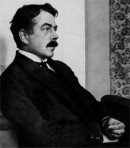 One of my 2010 reading resolutions (success rate of such resolutions: approximately 27%), which I’ve mentioned before and won’t again until and unless I fulfill it (I promise), is to read Robert Walser. Over at Two Words, Scott Esposito interviews Susan Bernofsky, a Walser translator who is also at work on a biography of him. She talks about why his work appeals to her:
One of my 2010 reading resolutions (success rate of such resolutions: approximately 27%), which I’ve mentioned before and won’t again until and unless I fulfill it (I promise), is to read Robert Walser. Over at Two Words, Scott Esposito interviews Susan Bernofsky, a Walser translator who is also at work on a biography of him. She talks about why his work appeals to her:
He has a way of describing the universe that walks a fine line between the maudlin and the trivially playful–and somehow he always manages to stay right in the middle, in that sweet spot where he achieves a sort of guileless profundity that takes the reader by surprise again and again. His literary fireworks are so controlled, so sly, so knowing, and all the while he’s got such an innocent look on his face.
She goes on to discuss the “microscripts” that Walser produced (the interview includes an image of these scripts, which really are something):
SE: I’d also like to ask you about a work of Walser’s called The Microscripts that is forthcoming from New Directions in your translation. As I understand it, these were writings that Walser made in such a tiny script that for a long time people simply couldn’t decipher them and thought they were some personal language that Walser had invented. . . . When translating these, did you ever work directly from the microscripts, or did you rely more on a fair copy that was easier to read?
SB: We decided to reproduce full-size facsimiles of the microscripts in this collection, and when you see them, you’ll understand why there are no more than half a dozen people in the world who can read them at all (and after many months of study). It took two devoted scholars twelve years to transcribe the six volumes of these texts. That’s two years per volume! In the late ’80s I watched them at work, peering through tiny magnifying lenses and discussing each word at length. These published transcriptions are what I based the translations on. I think of Walser’s miniature writing as a sort of shorthand he developed for his rough drafts, and he wrote like this for many years. There’s been a lot of speculation about why and when he developed this technique. The writing is an enormously reduced Kurrent script–that’s an old form of German handwriting people stopped using around WWII.

